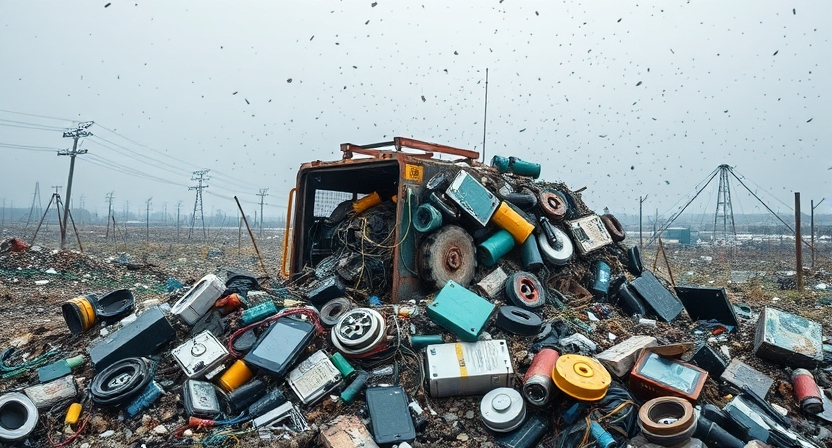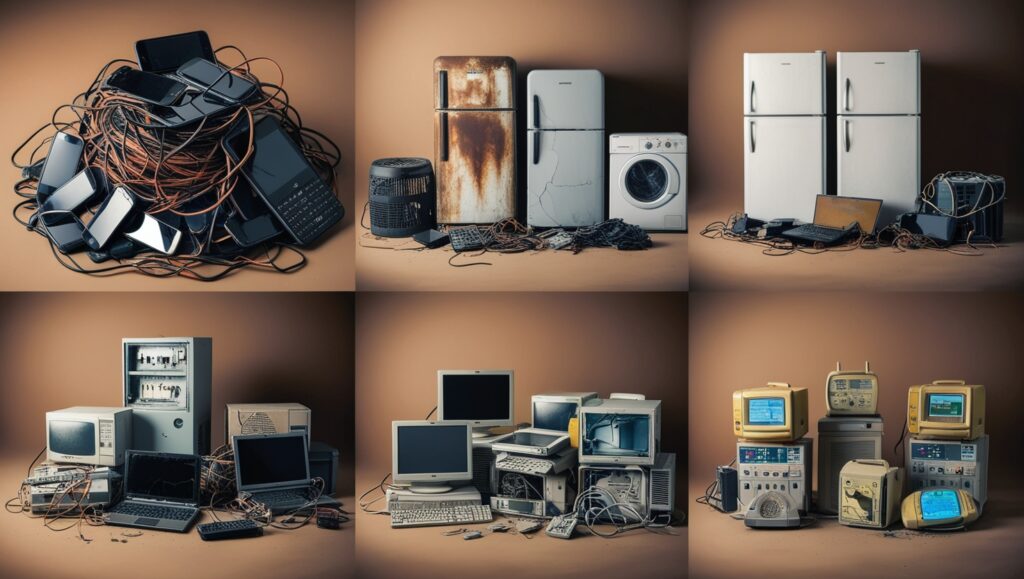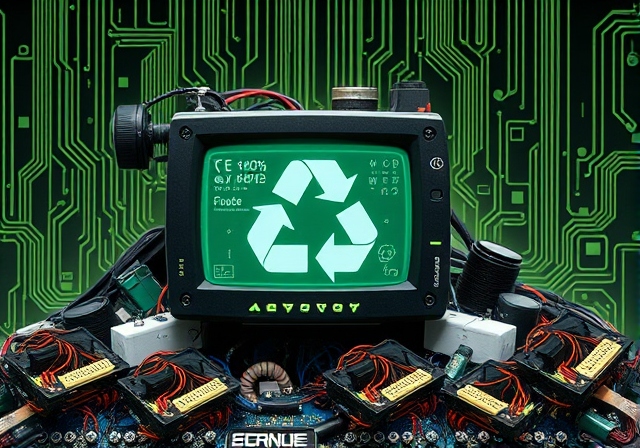E-waste – the dark side of digital graveyards
What is E-Waste?
In this digital age, technology plays an important role in everyone’s life. From smartphones to laptops, house appliances, medical devices, etc., electronic gadgets have become unreplaceable items. However, the rapid growth of technology also has led to an alarming increase in electronic waste. electronic waste refers to the discarded electronic devices and components which are no longer functional or desirable.
It is one of the fastest growing waste streams as globally it generated estimated 50 million metric tons e-waste yearly.
E-waste is just much more than waste collected as unwanted electronics, a reflection of the way of consuming nowadays. Besides this, our challenge regarding technology is progressing and so solving problems about electronic waste must focus on their sources, consequences and solution aspects

Causes of Generation of E-Waste
Rise in generation of electronic waste. These factors responsible for increase in volume of generation e-waste as follows
Short Product Lifecycles: Rapid technological advancements and frequent updates make older devices obsolete quickly. Companies release new models annually, encouraging consumers to replace rather than repair existing devices.
Consumer Culture: The demand for the latest gadgets leads to premature disposal of functioning devices. Society’s fascination with owning the newest technology drives higher turnover rates for electronic products.
Lack of Repairability: Modern electronics are often designed with limited repair options, forcing consumers to replace rather than fix. Many devices are sealed or use proprietary components, making repairs expensive or impossible.
Inadequate Recycling Systems: Poor infrastructure and awareness result in improper disposal of electronics. In many regions, recycling programs are either non-existent or underdeveloped, leading to informal handling and dumping.
Economic Growth: Increased incomes in developing nations have made electronics more accessible, thus increasing consumption and disposal rates.
Types of E-Waste
E-waste is a generic term that refers to a variety of items and is divided into two categories:

- Small Electronics: Mobile phones, tablets, digital cameras, and portable music players.
- Large Appliances: Refrigerators, washing machines, air conditioners, and microwaves.
- IT Equipment: Computers, laptops, printers, routers, and monitors.
- Medical Devices: Thermometers, blood pressure monitors, imaging machines, and pacemakers.
- Miscellaneous Items: Batteries, chargers, cables, lighting devices, and gaming consoles.
Others. electronic wastes; batteries and their chargers; cables; devices on lighting and all types of game consoles. It is this diversification with its mixture of toxic and resource wastes that really calls for difficulty in recycling, in particular at e-waste management.
Consequence of Electronic Wastes on Environmental Health
To dispose of improperly causes significant health impacts and degradation in the environment. Some major environmental impacts caused include:
- Environmental Degradation
- Toxic Leachate: Mercury, lead, cadmium, and arsenic are chemicals that seep into soil and water when e-waste is dumped in landfills. It affects agriculture and drinking water supplies.
- Air Pollution: Incineration of e-waste releases hazardous gases, such as dioxins and furans, contributing to air pollution and global warming.
- Resource Loss: Gold, silver, and rare earth metals are lost when e-waste is disposed of without caution, which raises the demand for mining.
- Ecosystem Disturbance: Toxic environments disturb wildlife and cause imbalances in ecosystems, creating long-term ecological imbalances.
Health Risks
- Worker Exposure: The informal recycling business often dismantles the waste by hand, with no protective equipment. The workers are exposed to toxic fumes and substances, which causes respiratory diseases, neurological disorders, and cancer.
- Community Hazards: E-waste mishandling leads to pollution of the surrounding water and air, causing adverse health effects in the community. Children are susceptible to developmental problems due to the presence of heavy metals.
- International Health Risk: The cross-boundary transportation of e-waste often leads to hazardous waste ending up in developing countries with weaker regulations, increasing health risks.
E-Waste Recycling Methods

Extracting valuable materials from electronic waste and properly eliminating hazardous parts constitute recycling. Key steps include:
- Collection and Sorting: Collection of e-waste from consumers, businesses, and collection centers. The e-waste is categorized according to the type and material.
- Dismantling: The reusable parts from hazardous elements are manually separated. This also entails identifying parts to be refurbished or repurposed.
- Shredding and Separation: Breaking down devices into smaller pieces to facilitate the recovery of materials such as metals, plastics, and glass.
- Refining: Extraction of precious metals like gold, silver, and palladium through chemical or mechanical processes for reuse in manufacturing.
- Safe Disposal: Non-recyclable and hazardous materials are treated to minimize environmental impact before final disposal.
Government Policies and Regulations
E-waste is being addressed globally through legislation and initiatives:
- Extended Producer Responsibility: The manufacturers are responsible for the disposal and recycling of the products. It promotes responsible design and end-of-life take-back strategies.
- International agreements: Basel Convention regulates movement of hazardous waste, including e-waste across nations. It makes sure that such hazardous waste does not enter developing countries to be dumped as a hazardous substance.
- National policies: India and EU bring out specific electronic waste management rules that require the proper collection, recycling, and disposal of e-products.
- Public Awareness Campaigns: Governments and NGOs create awareness about e-waste and the need for recycling.
Global Statistics on E-Waste
- Asia produces the highest percentage of e-waste, followed by Europe and the Americas.
- Only 17.4% of e-waste is formally recycled globally, and the rest is not managed.
- $62.5 billion worth of valuable materials are lost every year due to improper recycling.
- The global e-waste shall rise to 74 million metric tons by 2030, thus a serious attention towards this problem is required.
Issues in E-Waste Management
- Informal Recycling: electronic waste gets processed in informal units, which results in pollution and health hazards.
- Lack of awareness: Most consumers lack proper knowledge for disposal, hence most electronics are sent to the dumps or stored in a room.
- Economic Barriers: Recycling can be expensive and even less profitable compared to illegal dumping or exporting to developing countries.
- Technological Limitations: Poor recycling technologies have prevented the reclamation of resources and safe disposal of hazardous elements.
- Policy Gaps: Variations in rules and enforcement from one country to another exacerbate the issue.
Eco-Friendly Behaviors of Individuals and Corporations
For Individuals:
- Donate or Sell: Donate working equipment to those who may need them or sell them at second-hand stores.
- Choose Repairable Products: Select devices that are manufactured to be recycled and upgraded with ease.
- Take Part in E-Waste Recycling: Use third-party electronic waste recycling plants and collection activities.
- Reduce Acquisition: Buy just what is required and use equipment until they last.
For Corporations:
- Practice Circular Economy Approach: Manufacture products that will be recycled and reused.
- Environmental-Friendly Manufacturing: Use more environmentally friendly resources and minimize dangerous chemicals in their production.
- Engage Employees: Educate workers on proper responsible e-waste disposal and recycling.
- Support Recycling Initiatives: Collaborate with certified recyclers and NGOs to manage corporate e-waste responsibly.
E-waste management’s future
- The future of electronic waste management involves innovation and teamwork:
- Advanced Technologies for Recycling: The use of AI and robots in sorting and material recovery can maximize efficiency and accuracy.
- International Collaboration: There must be international collaboration on standardization of e-waste policies and practices to make it work in an effective, worldwide manner.
- Consumer Involvement: Awareness programs, incentives, and easy access to recycling facilities would encourage responsible disposal practices.
- Sustainable Design: The manufacturers should work towards designing durable, repairable, and recyclable products so that the amount of waste produced is minimized.
Conclusion
This is an issue for the world that it needs to address urgently. electronic waste is not only a product of modern challenges but also reflects the need for responsible consumption and disposal. Understanding its causes, impacts, and solutions will help individuals, corporations, and governments act in concert to minimize its harmful effects. Sustainable practices, innovative recycling methods, and strict policies will pave the way for a cleaner, greener future with technology and stewardship of the environment walking side by side.









